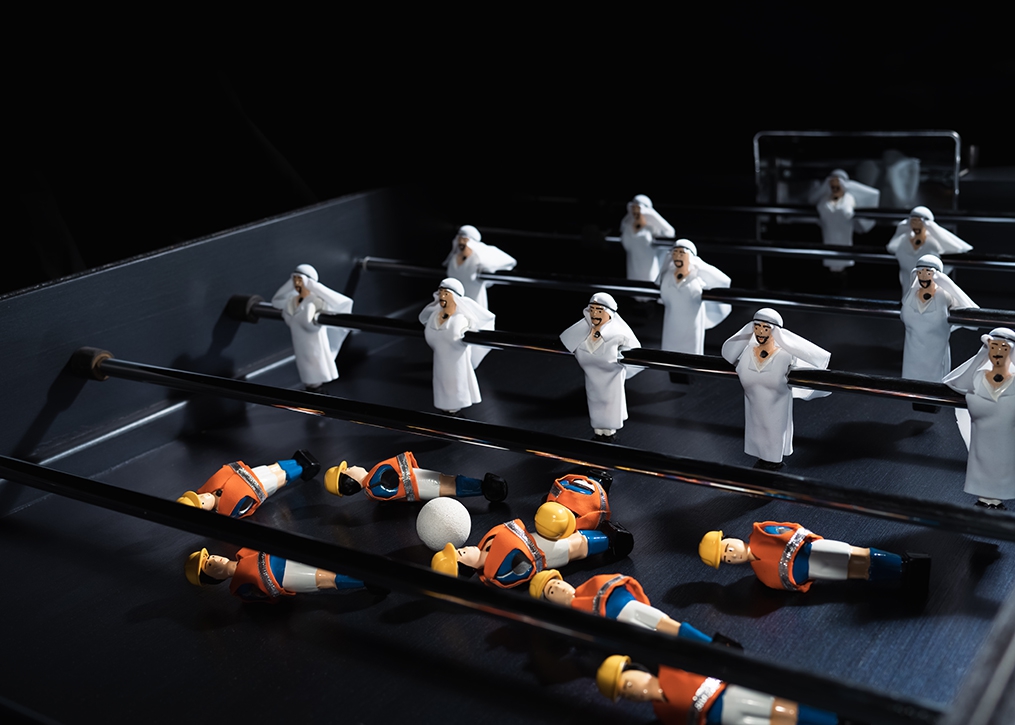
Views of the group show "It's play time'

The theme of soccer has been launched in the poetic world of artist Sung-Rea KIM. What kind of image will she paint for soccer? While all the participating artists talk about soccer through their own eyes, Sung-Rea Kim took the football, then went back to Genesis.
In Sung-Rea KIM's work, Adam and Eve are holding soccer balls and smiling brightly, soccer balls are also hanging all over the tree where the 'forbidden fruit' is located. Where does the courage of the author come from to overturn the 'forbidden fruit', the beginning of humanity and even the stories of the Bible? You can find this reason in the innocent faces of Adam and Eve.
Adam and Eve smile like children. This expression makes us forget the original sin of the man, from the tree 'with the forbidden fruit', and the countless hours of suffering from this original sin.
The appearance of this work is a hope that contains a more drastic peace than all other attempts. This is the message that the artist addresses to us. Chagall's "Expulsion from the Garden" is the only work in history that shows a happy face leaving the Garden of Eden. But now, one more work has been created, moreover, the artist has transformed the Garden of Eden into a happy soccer field.
The time of the audience,
'The hard core of the facts and the flesh of the controversial interpretation that surrounds it.'
I think Carr's definition of historical description applies to our exhibition as well. And what is more interesting is that there has been a lot of controversy about the World Cup, itself.
There has been a lot of controversy about the World Cup from the beginning. Recently, cities have boycotted the World Cup because it was not environmentally friendly. Countless human rights issues have been raised in the run-up to the World Cup. The treatment of the workers involved in the construction of the stadium has provoked violent reactions.
Qatar, one of the largest investors in the international art scene, has implemented numerous outdoor sculpture projects for the World Cup and presented them on a splendid and gigantic scale. He also regularly conducts seminars on the theme of Art for the Future.
The selection, analysis and interpretation are now in the hands of the public. In modern times and in contemporary art, as Duchamp said, the creator of creation is the public, not the artist.
The artist sees historical facts and creates his own work. The work of art that the public sees is a new reality.
Now it is the public's turn. In front of a work that has become a part of reality, the interpretation of the public is allowed, in all freedom!
It's playtime!
"It is the viewers who make the paintings. - Marcel Duchamp.
Jungmin CHOI
Curator
Doctor in Plastic Arts, Paris I Sorbonne
Ps. A soccer game is completely different when you see it on the field.
And the artworks are completely different when they are seen in an exhibition room.
Sung Rea Kim, In the beginning there was soccer (2022), h 45 x 40 x 27 Urethane foam, paper porridge, paper clay, wood, drawing, urethane coating
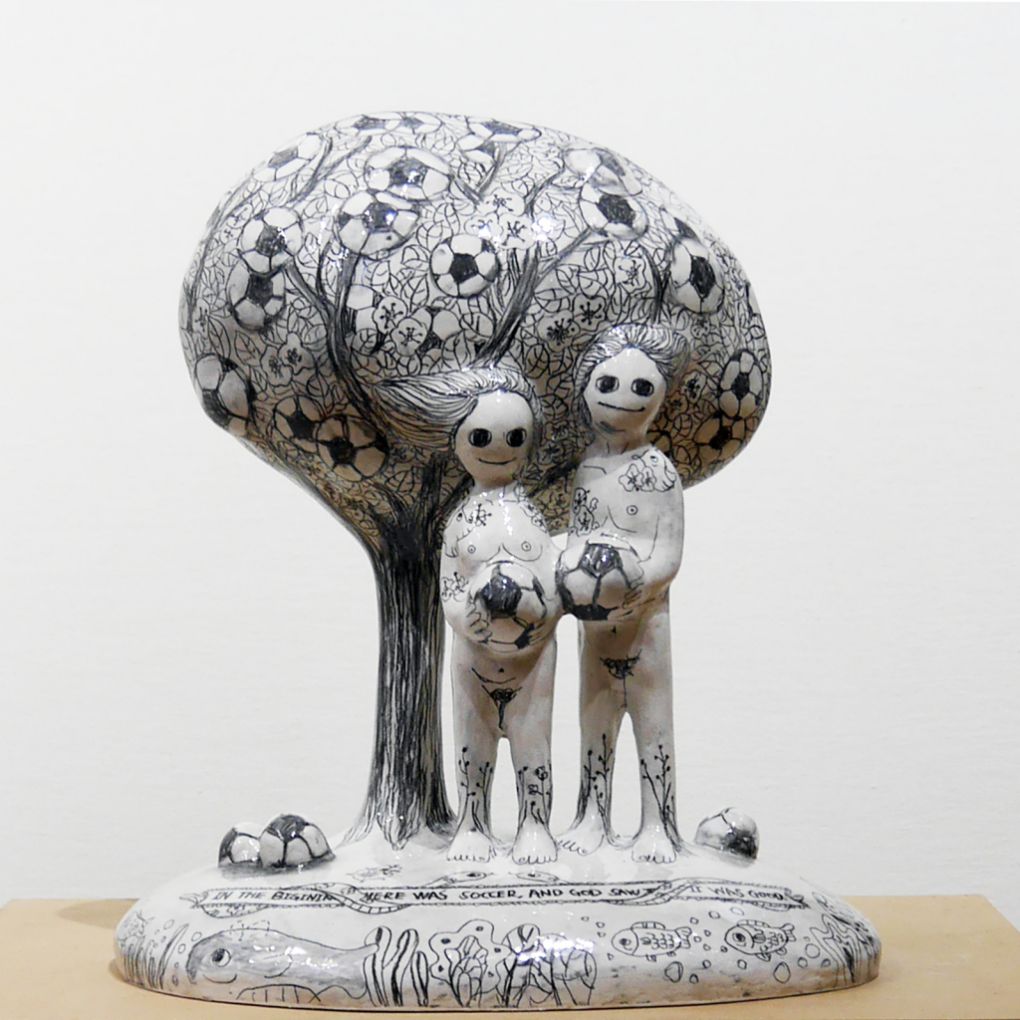
In his previous work, Sang-il OH dealt with deep questions about human loneliness. This time it is the encounter with soccer. With this theme the artist seems to rediscover the joy of his childhood. The juxtaposition of the shiny ball and the wings reminiscent of Harry Potter is fantastic.
The artist finds a heavy silence and peaceful solitude to encounter soccer amidst the dynamic changes of a glowing modern society. Faced with this subject, carrying a heavy past on his shoulders, he returns to his childhood, speaks of hope to children but also of the hope he received from children.
Because a football is round, you don't know where it's going to roll. It's like life. In rich and poor countries, children are content to play with a small soccer ball. When we watch soccer, we forget the worries of reality. We receive consolation by watching children play innocently with the ball. Just like soccer, the artist shows us pieces that comfort us.
Sang-Il Oh, Flying to the moon, (2022), H 54 x 64 x 20 cm Glass fiber, FRP, chrome plating, stainless steel, sea black stone / Timbuktu (2022), H 46 x 20 x 20 cm Glass fiber, FRP, chrome plating, stainless steel, sea black stone
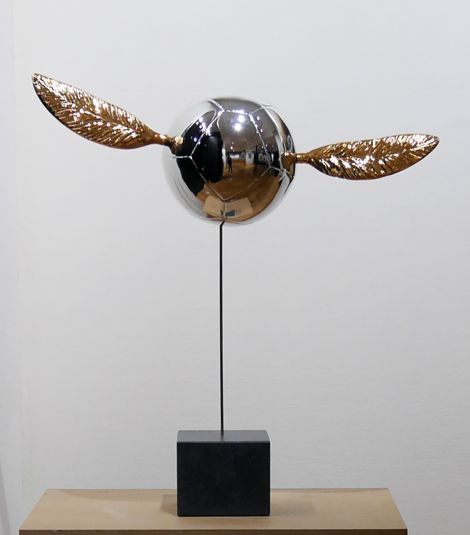
Se Young Kwon- Jeu jouable II, III, IV (2022), Pigmentary print (H 40 x 30 cm) on Hahnemühle 325g paper, Aluminum Frame 60x40cm
Polat Tayir - Paysage dans le gant I, II, III (2022), 12 x 21 cm - oil painting on worker's glove
Photography, which pushed painting to the brink of death due to the development of reproduction techniques, is now also on the brink of death due to the new era opened by the iPhone. The infinite digital age is not limited by film. In an age where we have all become photographers, in an age where no one is looking for pictures, the photographer, Se Young Kwon, is always looking for a picture.
Paul Virilio said "a flood of the image is the industrialization of oblivion". Our world moves fast. It is not easy to stand still while looking at the landscape. Here Se Young catches the ball and captures its shadow.
Our era craves images. "I take selfies. Therefore I exist." We prove our existence with a 'selfie'. In this way, the photo is gone, leaving only the image and the desire.
Looking towards the world of soccer and the objects that surround it leads Kwon to unveil a photo printed on paper and not on a smartphone screen. A nod to Anselm Kiefer's advice that "works should be seen at the exhibition site". Photos on paper and not a screen.
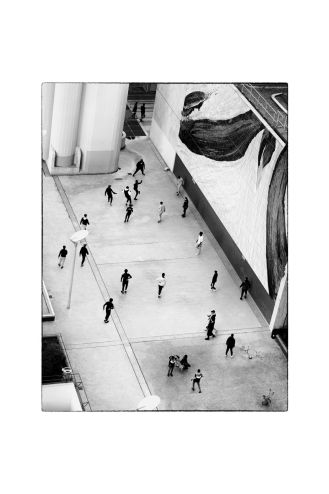
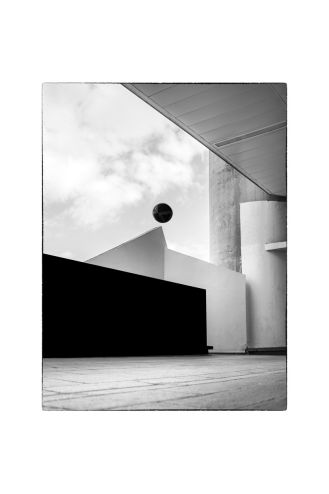

The worker's glove is a realistic and existential object on which Polat Tayir paints workers and footballers. A creation that recalls the hand of the worker and his work on the construction sites. Splendid stadiums that are the result of countless hours of work provided by the workers. Polat's brush is expressed on a simple cotton glove, not on a glamorous canvas. The lives of countless anonymous workers that no one will remember are depicted on these small cotton gloves.
Although these gloves are not as flashy as the splendid stadium in Qatar, they refer to the many hands that shaped it. An artistic expression of the daily life of unknown workers.
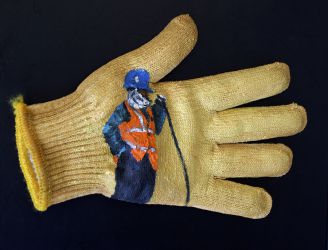
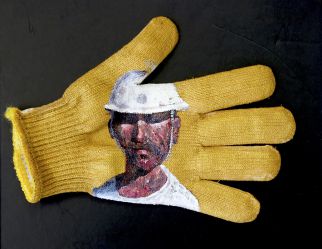
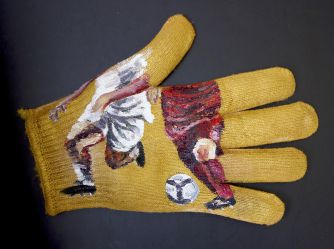
Clovis Petit creates his own organization. He calls it 'kit'. His kit is unique, all the elements are sculpted by the artist's hand. The kit he produced starts from the anatomy of the human body. It refers to the era of robots. It shows the beauty of the human body and the precision of manufacturing.
Here his kit shows a player preparing for a soccer match. The artist has chosen the color of Ukraine and Russia. He gives his kit a political and sociological character by choosing the colors of two countries at war. Two countries confront each other but it is not like a soccer match. War is followed by death and innocent victims. These two kits evoke the hope of a confrontation without horrors, without deaths, without destruction. A peaceful competition like soccer.
Small cubes without expressions are assembled to form the legs, arms and bodies and give life to these kits. The artist tells the story of war through a game. While the world cheers for soccer, he reminds us that war continues.
Clovis Petit, (2022) KIT Footballeur (UKR) and KIT Footballeur (RUSS) - Wood (poplar), stainless steel bolts, nuts and washers, beads, collars, vinyl glue, acrylic paint. 4 interchangeable sides. H 30cm
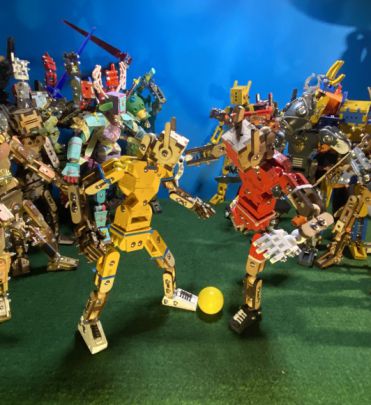
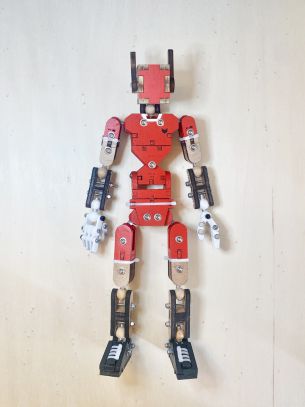

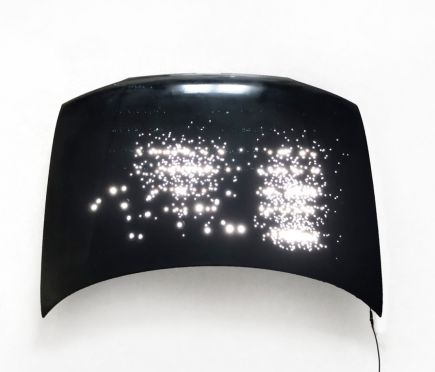
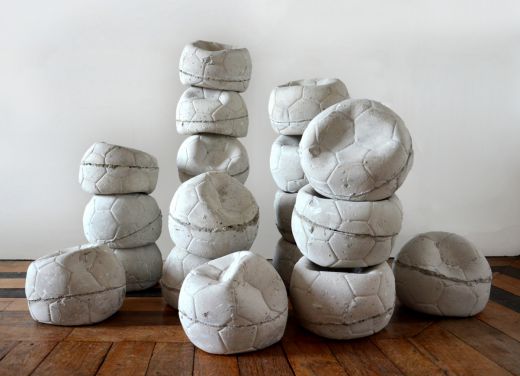
The Magic of Football
Dmitri Shostakovich was one of the greatest Russian composers of the 20th century. After his teacher Alexander Glazunov, he is the second musician to have written a symphony as a teenager when he was only 19. A work of maturity, grandeur and scope that does not suggest his young age.
Despite his brilliant genius and fabulous beginnings, his life and musicality were not motivated by splendor and recognition but by the fear of death. He lived under the Stalinist regime where people were captured and killed without a word. The Great Purge definitely cast a shadow over his music, his life, his time and even his features.
Curiously, while his life was frightening and dark, the portraits that represent him show a man with a childlike smile.
He was a great football fan. He even had a referee's license and was always telling stories about soccer in the letters he exchanged with his friends to forget a tragic life in which the slightest incursion of the secret police could mean a death sentence. This is "the magic of football".
In the work of Nicolas Demeersman we observe a certain tension due to opposite elements. The artist stages paradoxes. For example, beauty and the grotesque, the serious and the funny. A beautiful woman, with her mouth open, swallows an octopus while a serious-looking man gives her the finger.
The artist creates a scene, then takes a picture of it. For this kind of work, it is necessary to have a subtle plan either aesthetically or narratively. The viewer knows that this scene is not the fruit of chance. The viewer is well aware of the artist's intention in this scene that he has imagined and photographed. In the case of Nicolas, the photo succeeds in composing a scene that seems to take place in the real world. Between the verisimilitude of reality and the situation staged by the artist, there is a tension despite the consistency from beginning to end. This approach is in the very nature of the artist's work.
Here to speak about soccer, the artist chose the 'table soccer'. It is a fabulous object, a universal toy. The characters wear the uniforms of the national team. He puts there in parallel and in tension a simple game and a uniform of national team which can bring a political sense. He throws a ball of suspicion and shows under the appearance of a game the uniforms of two countries of the West and the Middle East.
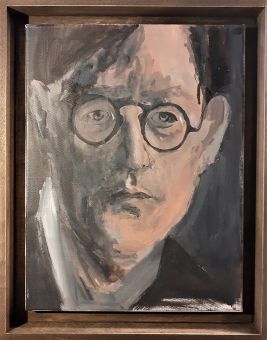
I T ' S P L A Y T I M E !
G R O U P S H O W


Benjamin Grivot's look is provocative and sociological. His car hood, which seems to have nothing to do with soccer, speaks of a forgotten history. This work is about the execution of the death penalty in Qatar. It is a more provocative attempt than any other work.
(Anil Chaudhary's execution) https://www.lorientlejour.com/article/1259429/execution-dun-condamne-la-premiere-en-20-ans-denonce amnesty.html#:~:text=%22The%20Qatar%20has%20resumed%20the,2020%2C%20according%20to%20the NGO.
This case has been forgotten and it is a question about the current era that remains silent on the death penalty. Next to this accusation, he placed a column of deflated balloons. It is a kind of irony or emptiness as a non-return answer about life and death. He built five towers with cement, a paradox in which a heavy cement block expresses a deflated balloon. With a deflated ball the tension around soccer seems to have disappeared in an instant. In any case, it's win or lose. After a match, the ball is deflated but here, with the weight of the cement, it stands upright even though it has been emptied of some of its air.
Nicolas Demeersman - Babyfoot V, 2022 -Edition 1/3, Numeric photo (30 x 42 cm), Hasselblad, Print on Fine art paper, Framed H 42,7 x 52,7cm
The historical event and the artists' view
The 2022 World Cup is being held in Qatar, for the first time in winter, to avoid the sweltering heat of the Middle East.
If more than 150 countries from all over the world participate in the Olympic Games, only 32 countries have been selected for this international sports competition after very strict selections. All the countries participated in the qualifications.
To play soccer you need a goalkeeper and ten players. Only the goalkeeper can touch the ball with his hand but not the players. A point is awarded if the ball is kicked into the opponent's goal with the feet, head or body. The team that scores the most points wins. Simple rules that keep the world excited for 90 minutes.
An accomplished sport that brings people together and overcomes divisions. Political parties and different religions become one under the national flag. All citizens become fans of their country's team and finally patriots. We cheer when our team scores and we are sad if we lose the game. How to interpret and explain this simple and surprising phenomenon?
The British historian Edward Hallett Carr defined historiography as 'The hard core of facts and the flesh of the controversial interpretation that surrounds it.' He describes the facts from his point of view. The fact that existed is the hard core and the historian's interpretation is what is around the core. This solid fact and the historical description that is added to it meet to form our 'story'.
The artist is not the historian. However, artists also express themselves on the "solid fact" with their "own creative perspective". The intervention of the artist for the event of the history is thus realized. Goya painted the horror of war and Picasso also spoke out against war in his work, Guernica. The artist adds "artistic flesh" to the hard core. In this exhibition seven artists explain, express, introduce, claim and accuse with their own language the solid fact of the World Cup.
The seven artists participating in this exhibition are both players and coaches. They play their games with their own style. Sometimes intensely, sometimes controversially, sometimes radically and calmly, they speak about this subject each with their own language. The subject is soccer and its environment. The artists talk about this World Cup but also about the world that promotes the World Cup. They tell the story of the shadows cast by the eight splendid World Cup stadiums from which the cheers of the crowd will rise.
Benjamin Grivot - Anil, (2022) - 135cm x 105cm x 12cm, Car hood , wood and LED / Monuments (2022), Concrete, iron - variable dimensions (one balloon 20x20x15 cm)
Portrait of Dimitri Chostakovitch, Jungmin CHOI (2022),
35 cm X 27 cm ,
Acrylic and ink